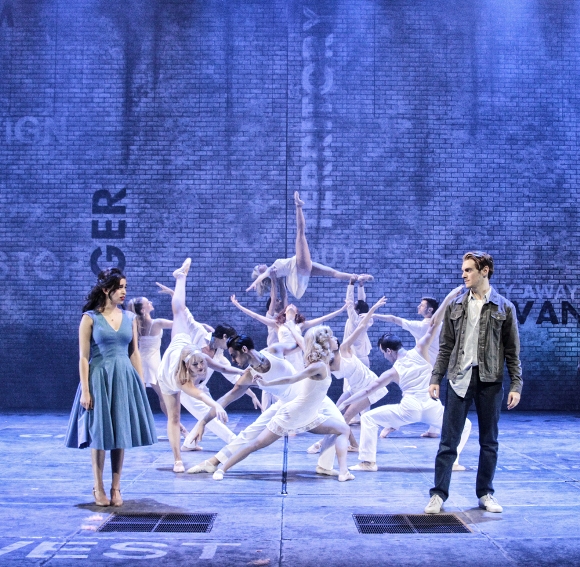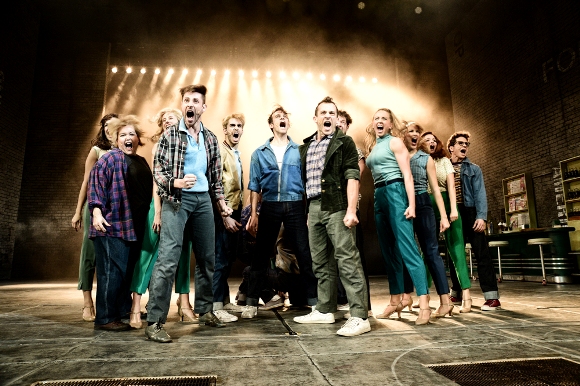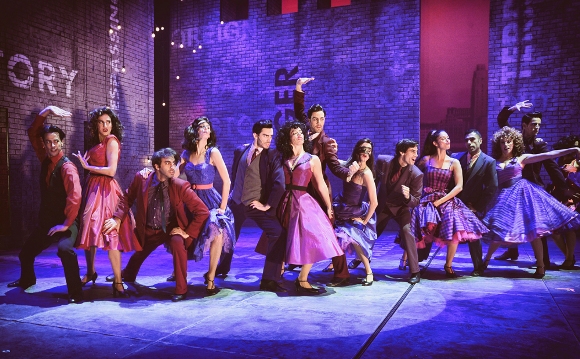The Cameri Theatre production of West Side Story is simply marvelous! Capturing the excitement of youthful energies, and the thrill of surging emotions, with music, song, and dance, it is outstanding!
The original West Side Story was created by such an exceptional team that any revival faces a serious challenge. Director Tsedi Sarfati and the many creative talents involved here – from Eli Bijaoui’s translation, to the choreography by Avichay Hacham, and musical direction by Amir Lekner – infuse this production with such exuberance that it all feels fresh and new. One of the risks in presenting West Side Story is that audiences everywhere know it so well, that everything has to be perfect – and it is!

Leonard Bernstein’s music is simply immortal, these are some of the best songs ever written for the stage. The music alone inspires an ocean of feeling, and the live orchestra (offstage) delivers a wonderful performance. Sarfati has found precisely the right tone for this work, a youthful lightness that can turn into the darkest abyss with the flick of a knife.
Meshi Kleinstein made an impression on me last year with her poignant rendition of the song Frank Mills in Hair. Now center stage as Maria she truly shines. The clarity of her voice is imbued with sweetness and warmth, she is an expressive singer, and so well suited to convey Maria’s innocence and eagerness, acquiring depth through love and loss. Ido Rozenberg really makes one feel Tony as a teenager trying to become a man, full of desires and energies that he does not quite know what to do with, as so well expressed in songs like “Something’s Coming” and “Maria.” My one caveat is with Tony’s hair, which in this otherwise visually impeccable production, stands out as overly artificial, which is a distraction. The two young lovers are beautiful together, when Tony and Maria meet, the world literally stands still.

As well we know, this young love blossoms in an unlikely setting, against a background of urban poverty, racism, and conflict between rival gangs. The set design by Eran Atzmon reflects the grim setting with its gray brick, graffiti, rusty fire escapes and gloomy horizon. Ula Shevzov’s costumes remind us of the liveliness and loveliness of youth, which will bloom in any setting, even if only for a brief moment. Alluding to the period, yet not at all in an overbearing way, the great success of the costumes (in addition to the fact that they are beautiful and I’d love to wear some of those dresses) is that Shevzov creates a distinction between the Jets and Sharks which is easily perceptible yet subtle. The Jets wear chinos, jeans, plaid, sweaters and white muscle Ts, while the Sharks have a darker look, black trousers, a red shirt, and a leather jacket or two. Best of all, the costumes let them look like individuals. Yes, of course, as a group they are quite color coordinated, which looks great, but they really do look like two groups of teens.

The feeling of belonging to a group and the tensions of being an outsider are central to the show’s themes of immigration and racism – all expressed so well in song! The choreography is terrific, like the music, it is a main character in this story. In America, one of my favorite numbers in a show that just has one amazing song after another, the girls dance out their dreams of America and the freedoms it offers, as much as they sing them. The song “Officer Krupke” offers a lesson in the perils of the educational and social welfare system, and the pervading sense these kids grow up with that there is no way things can ever be right for them, yet it does it all in a hilarious and entertaining way. Dance and stage combat scenes – kudos to Ilan Gazit – are mesmerizing, full of action, grace and exhilaration. Eli Bijaoui has done an excellent translation, the words flow very naturally and yet it’s not too trendy.

Last but certainly not least, Rona Lee Shimon makes a sensational Anita. This role lets her express her dancing ability as well as her acting talents. Shimon has a fantastic stage presence, strong, sexy and graceful. Although Maria and Tony are at the center of this story, Anita is actually called upon to express a far wider range of emotion, and undergoes as many – if not more – changes. Musical theatre is a very over-the-top genre, and Anita is a powerful character, capable, confident in her sexuality, confronting any attempt to hold her back, she’s a fighter. There is a slight tendency in her first scenes, which are quite fun and humorous, to give a little too much. Some modulation in her tone and less volume would make this a perfect performance. Yet even with this caveat, she is a delight to watch in all the dance scenes, a sparkling gem in this wonderful production.
West Side Story
Based on a conception of Jerome Robbins; Book by Arthur Laurents; Music by Leonard Bernstein; Lyrics by Stephen Sondheim; Original production Directed and Choreographed by Jerome Robbins; Translated by Eli Bijaoui; Directed by Tsedi Sarfati; Choreography: Avichay Hacham; Music Direction: Amir Lekner; Set: Eran Atzmon; Costumes: Ula Shevzov; Vocal Coach: Doki Atzmon; Corepetiteur: Nadav Rubinstein/Ohad Ben-Avi; Sound: Eran Perldik; Stage Fights: Ilan Gazit; Producer: Haim Sela; Assistant Director: Haim Filiba; Assistant Choreographer: Dana Shoval; Cast: Tony – Ido Rozenberg, Maria – Meshi Kleinstein, Anita – Rona Lee Shimon, Bernardo – Gilad Shmueli, Riff – Yitzhak Mizrahi, Doc – Shlomo Vishinsky, Schrank – Oded Leopold, Krupke/Glad Hand – Aviv Zemer/Tal Weiss.





